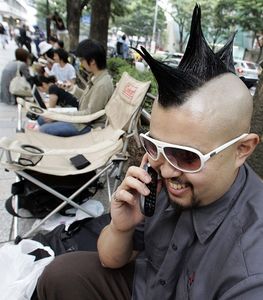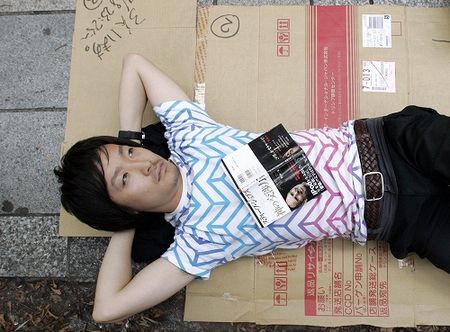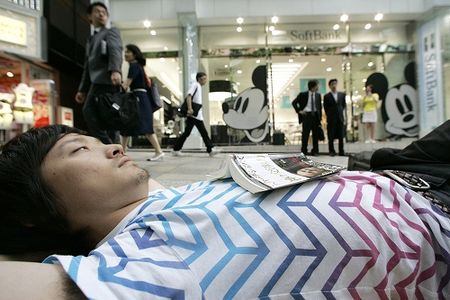Work is a way to earn a living and add meaning to one's life. But
too much work is unhealthy for the body and soul and is a factor in
many problems, including that of the declining birthrate, and achieving
a good balance between work and life is a giant task. Here, the
Mainichi looks at some of the common questions about long working hours
in Japan and their adverse effects.
Q: What exactly does "Work-Life Balance" mean?
A: Literally, it means striking a good balance between working and
living. Japanese workers are working shorter hours than they were in
the high-speed economic growth years from the mid-1950s to early 1970s,
but are still working longer than their counterparts in other developed
nations, and this has led to various problems. This, in turn, has led
people to think that we need to balance work and life in a better way.
Q: How long do Japanese people work?
A: The Organization for Economic Cooperation and Development (OECD)
conducted a survey of working hours in Japan, the U.S., Britain, France
and Germany, and found that Japanese work an average of 1,784 hours per
year. This is 13 hours less than the Americans, who work the longest,
but 348 hours longer than the Germans, who work only 1,436 hours.
Another survey of 18 developed nations indicates that 28.1 percent of
Japanese workers work more than 50 hours a week, the highest percentage
among the surveyed nations.
Q: Do the Japanese have fewer holidays?
A: In western nations, it's normal for workers to take two to four
weeks of vacation in summertime or at Christmas. In contrast, while
Japanese workers are entitled to an average of 17.7 days of paid
vacation every year, in 2006 they actually took only 8.3 of those days
off, only about 46 percent of their entitlement. In addition, although
the Child Care and Family Care Leave Law allows both men and women to
take parental leave, only 0.5 percent of men took the leave in 2005.
The law has become a mere facade.
Q: Aren't the long hours simply an expression of Japanese diligence?
A: That may be one aspect of the matter, but there is also the
problem of productivity -- in other words, how effectively people work.
The Japan Productivity Center for Socio-economic Development conducted
a comparative study of productivity in 30 OECD nations for the year
2005, and Japan ranked 20th. It ranked lowest of the seven major
nations of Japan, the U.S., Britain, France Germany, Italy and Canada.
So the Japanese are working for long hours at a low rate of
productivity, which means they are working inefficiently.
Q: What are the problems of long working hours?
A: Working too long is bad for your health. The Ministry of Health,
Labor and Welfare reported that 268 people claimed worker's
compensation for work-related mental health problems in fiscal 2007.
Eighty-one of these cases involved suicide or attempted suicide. Both
figures are double those for fiscal 2005, and are the worst on record.
Heart and brain disorders were also at an all-time high, with 392 cases
recognized as being work-related. A total of 142 of these ended in
death. If we include those still trying to claim compensation, there
are clearly many, many more who have damaged their health through
overwork.
Q: Are there other problems as well?
A: In Britain, men participate in childcare for an average of 90
minutes per day. In Sweden, the figure is 70 minutes, and in Germany,
59 minutes. In Japan, it is a mere 25 minutes. Men are so busy working
that they are leaving their children entirely to their mothers. Long
working hours are taking time away from families and are said to be a
factor behind the declining birthrate.
Q: Why has there been no improvement of the problem?
A: There are many complex and interrelated factors. Many firms
stopped hiring after the collapse of the economic bubble, and the
shortage of mid-level employees has led to an excessive workload.
Another possibility is that the escalating competition brought about by
the global economy has made it hard for the employees of many small and
middle-sized enterprises to make ends meet without working overtime.
There is also the problem of temporary staff, who face unstable job
situations and are thus forced into working long hours. "National
character" may also be a factor: the long working hours of the Japanese
have been famous since the economic boom years.
Q: What about the issue of national character?
A: A 2007 opinion survey conducted by the Ministry of Health, Labor
and Welfare shows that 25.2 percent of respondents report "hesitation"
about taking a paid holiday, with another 42.5 percent reporting "some
hesitation." The reason given by 66.2 percent of these respondents was
that they feel they are "causing trouble for co-workers." The ministry
asked women why they didn't take childcare leave, and more than 40
percent cited "the atmosphere of the workplace" as their reason. This
seems to indicate that the Japanese feel guilty about taking time off
while others are working.
Q: Are the government and businesses taking steps to do something about this?
A: Last December, representatives from the government, business and
labor sectors established a Work-Life Balance Charter and certain
Guidelines for Action. The Guidelines are directed towards: 1) economic
independence through work, 2) ensuring enough time for a healthy and
bountiful lifestyle, and 3) having a choice between various ways of
working and living. To realize these goals, 14 specific numerical
targets were also established, such as increasing the utilization of
paid holidays from the present figure of about 46 percent to 100
percent by 2017, and raising the percentage of women who keep working
after the birth of their first child from 38 percent to 55 percent by
the same year.
Q: Is working too long a problem for society as a whole?
A: Japan is becoming an increasingly aged society, with a declining
birthrate. If we don't create an environment where everyone can work
efficiently and easily, industries are in danger of stagnating.
Companies are beginning to see the danger, and some are making efforts
to cut overtime and to get more people to take childcare leave. The
only way to succeed is for both management and labor to change the way
they think.
--
The Mainichi also discussed the balance between home and work life
with novelist Kaoru Takamura. Takamura shares her thoughts below:
--
I was a company employee before becoming a writer, and I shared the
vague belief that "Japan is a land of third-class politics and a
first-class economy."
This belief was overturned entirely with the bad loan debacle of the
1990s. A legitimate businessperson offers a loan after taking a good
look at the borrower, and he or she takes the responsibility for
mistakes in judgment. Apparently, such commonsense rules were not being
followed. Since those years, I have given up the idea that Japan's
economy is first-class.
What we learned from the bad loan problem was that although Japanese
companies have a command structure, there is no clear system that
distributes "authority and responsibility" within a company. The lines
demarcating an individual's authority are unclear, which means that the
limits of responsibility are also unclear. Employees are never clearly
instructed about their own authority and responsibility.
It seems to me that the root of the problem of excessive work habits
in Japan lies here. In an organization where the
authority-responsibility structure is unclear, employees are unable to
make their own decisions and must constantly refer to their superiors.
But because these superiors are also unclear about their own authority,
they can't make responsible decisions. Problems just get shuffled
around and everyone ends up working longer hours.
Because individual authority and responsibility are left unclear,
the criteria for evaluating an employee's work performance are also
unclear. In a situation where it's unclear what you need to merit
praise, it's impossible for employees to work efficiently. An "all for
one and one for all" mentality becomes the focus.
With such ambiguous criteria, I don't think it's enough to do things
like creating a men's childcare leave system in order to achieve a
work-life balance.
Employees are bound to think: "I'm worried about taking leave when
others don't. I'd rather not behave differently from other people."
On the surface, it may seem like businesses have survived the bubble
crisis by laying off older workers and introducing temporary staff, but
the real problem -- that of "authority and responsibility" -- has been
left to stand.
The solution is not the creation of more systems, and industry leaders need to make a basic reassessment of their organizations.
Profile:
Takamura, 55, received the Naoki Prize for her novel "Marks'
Mountain" and the Mainichi Publishing Culture Award for "Lady Joker."
Her other works include "New King Lear."
(By Keiichi Shirato, Mainichi Shimbun)
Mainichi Japan, 31 aout 2008





 (Mainichi - August 8th 2008)
(Mainichi - August 8th 2008)







